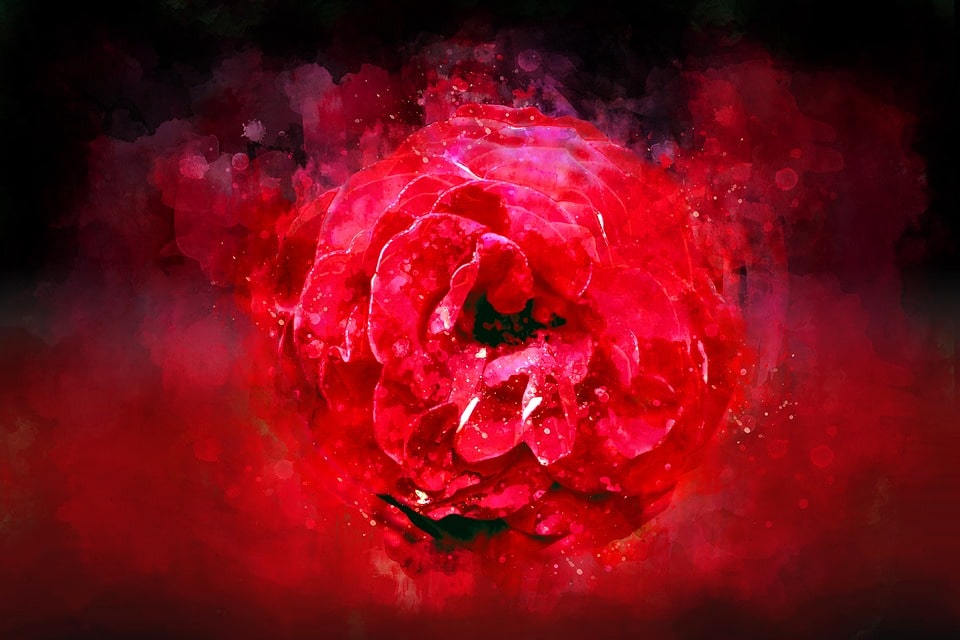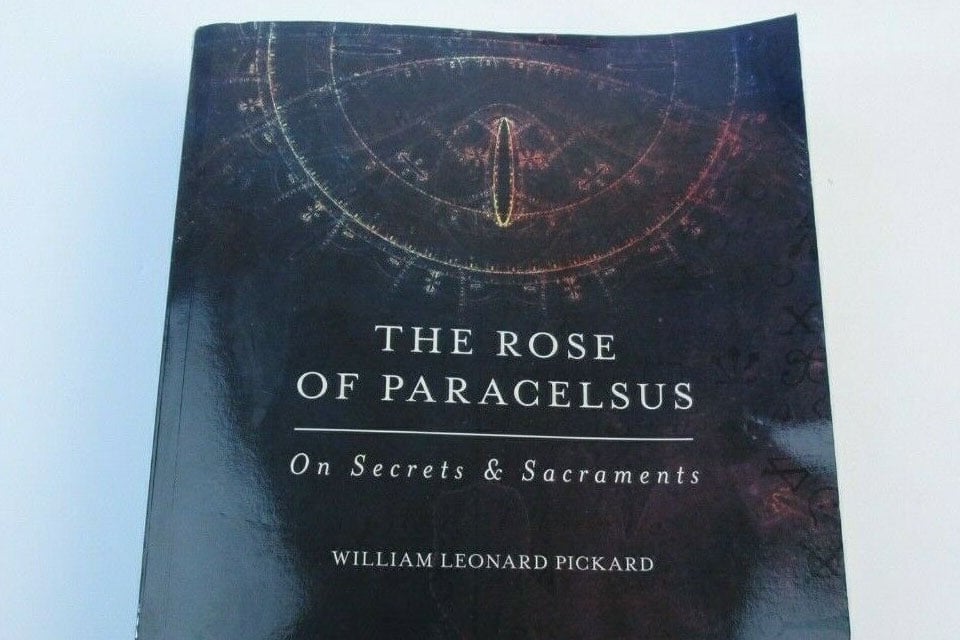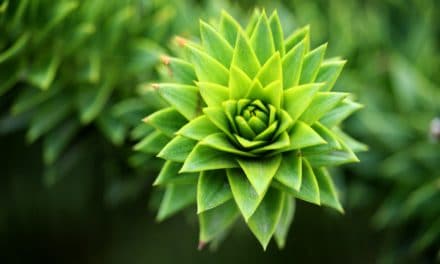
This book review of The Rose Of Paracelsus is by guest contributor David Lee. You can visit David’s website here and contact him via email here.
The Rose of Paracelsus was hand-written on paper, in the US prison where Leonard Pickard is imprisoned for “conspiracy to manufacture LSD.” I finished reading the book a few months ago, and I say ‘finished’, but that was just the first read through. I may be coming over as a bit OTT on this, but it really is one of the finest prose works I have ever read, an extraordinary, multilayered outpouring of one man’s vast knowledge, phenomenally weird life experience and global vision.
That’s the elevator-pitch review. But although it’s immensely readable (at least for weird-science-magic folks like me) it is also challenging. It carries an aura of self-importance, because it deals with big issues and very dark experiences in a way which is deep enough not to stop at mere blame of the perpetrators or the political context. The approach to human suffering is respectful, sacred, committed.
Where do I start, with such a book? Because there isn’t any other book like this. The scale and ambition is bigger even than such a multilayered world-novel as Pynchon’s Gravity’s Rainbow. And much as I enjoyed that memorable book, for me this is a much better one, because its towering seriousness racks up the intensity. Having said that, it also has to be said that not only is the prose as luminous, culturally rich and loaded with clever subterranean depths as Borges, but it’s also a fun, sexy, visionary read, a kind of illuminist hyper-thriller.
Maybe the best way to talk about it is by dividing it into layers.
Let’s start with the main character—who is of course the author, under layers of disguise of varying thickness. He is a Harvard postgrad, on a course which fits him to be a US government policy wonk, work which he is already doing while studying. He is someone who has undergone various kinds of monastic life, confinements both voluntary and coerced. These elements all correspond to Mr. P’s timeline in the outer world.
The Harvard scenes set our character up in the early chapters. He is researching a report on a unique ‘criminal’ underworld— a group of LSD manufacturers known as ‘The Six’, globally networked, with their own alternative world of counter-espionage. The Harvard world is of course that of a super-elite; the protagonist’s companions are extraordinarily beautiful as well as super intelligent. This is the first layer—a core of elite people inside US government, a cabal of high flying idealists in foreign policy, far-sighted thinkers who are being trained to push for influence.
Another layer is the monastic theme. Leonard relates four kinds of life experience that have monastic dimensions. First, the insanely intense academic discipline of the super-students at Harvard. Then there’s the Zen monastery where the protagonist lived before his ascent to Harvard. Then the hell of long-term incarceration, and finally the life of Crimson, the security expert amongst The Six.
Three of these confinements are voluntary and the other is coerced, but all of them tell us something of what Leonard Pickard is. An astrologer might find some interesting details in Mr. P’s birth chart in the region of the Twelfth House, the zone of confinement and secrecy. The monastic life is certainly a pull for some initiates. Reading the descriptions in RoP of life in a US Zen monastery gave me my first glimpse into what such a commitment could mean to some people. The idea of asceticism has generally (but not always) repelled me, striking me as probably unbalanced, but here is a man for whom it is at least one perfectly reasonable way to lead one’s life in the face of the world’s insoluble darkness.
I once read an account by a friend of some of his early magical experiences. At that time, I found quite disturbing his account of living without any pleasures (all those in which he indulged solely for the immediate experience). My thought was: But those things are what makes life worth living! My friend returned to some of those pleasures (I’ve drunk wine with him in recent years), so he’d been describing an exercise to reorient himself to the joy in life that comes when one is not consuming any particular experience. I felt like that for a while, back in my teenage acid days. I knew that what I wanted, beyond the many objects of my immediate desires, was an unconditional appreciation of life, an appreciation that was not conditional on consuming pleasures. That’s a good perspective to have for enjoying life.
But that is not the monastic life. In such a world, everything is held together by willed effort—down to every mouthful of food you eat, down to the stitches in your robe—how many there are and who stitched them. These minute, repeated, endless gestures of caring for every atom of the universe make such a commitment comprehensible, in a way which is quite terrifying. Such a fanatically-detailed commitment I can only understand in terms of a profound desire to serve the world, and this is a central theme of the book.
The vow to serve the world ties much of the story together. Even religion, which every initiate of higher consciousness knows is largely social-control programmes built from the dregs of visionary experience, is used to positive effects by The Six. So for instance, Catholic prayers and Buddhist blessings are used to relieve suffering in people whose lives are close to unbearable.
On the surface, you can read this story as a Borges-inspired poetic thriller about an academic and US foreign policy advisor investigating LSD manufacturers. But the whole story is grounded in a vision of the sorrow and horror of the world and the meticulous spiritual dedication needed to function in the face of that horror. In other words, the tale can be seen as a description of the working out of the vow of the Bodhisattva, the spiritual warrior-monk who incarnates again and again until all beings are awakened and released from their suffering.
The occasional references to fitness also make sense in this context. These people are, basically, elite warriors of the spirit. And in the fourth monasticism, the involuntary one of prison, Leonard faces the hardest challenge of all. Not many prisoners write a book, and fewer still will ever write a book as important as this one.
Another layer is the conspiracy. The Six are known by colour names: Cobalt, Magenta, Crimson, Indigo and Vermilion. (Yes, there are only five. And all male. More on this below.) All of them individually manufacture LSD, but each of them has a speciality: Crimson, the first of The Six we meet, relays this information. His own speciality is ‘basic security’; Indigo ‘contemplates ritual preparation of the Eucharist, the sanctity and precision of labs, and their surreptitious transfer from site to site. Vermilion monitors distribution; he conducts downstream counterintelligence with gifted women operatives’ … Magenta is concerned with ‘research, the future, anticipating neuroscience, the next touchstone of evolution. Cobalt considers high-level threats, infiltrates governments, and watches intelligence agencies.’
Their roles do, of course, underlie the themes I am identifying in the book. The total idea is a real thriller, if you like this kind of thing: a covert agency, working as a bright parallel to the darkness of government agencies. And it is not just The Six. As Cobalt discloses, there is a whole apparatus of counter-intelligence inside the government security services:
‘The initiates,’ he continued, ‘are now third and fourth generations. They are ultimately unstoppable, unrecordable by hostile analysts. They are lifelong sleeper agents. We watch the watchers.’
The drugs themselves are obviously a major theme. Acid is the great medicine, which has the potential to undo some of the damage caused by other drugs in the world. Leonard as US drug policy adviser has forward-seeing ideas about the global opioid trade, from the dynamics of the Taliban to forecasting the immense harm potential of the fentanyl series. But the acid stories are king. We read an account of Indigo’s accident during manufacturing—the chemist is drenched from head to foot in an entire production batch of pure LSD solution, around 10 million doses, and prepares himself for death. After all, nobody had ever reported taking such a dose, and this seems the logical outcome as he lays shivering in his laboratory. This beyond even those extraordinary reports of major acid dealers taking ‘thumbprint’ doses, where you wet your thumb, dip it in the crystals and lick it. These are recorded in the excellent Heads, a Biography of Psychedelic America, by Jesse Jarnow, wherein such doses are estimated as 70,000 micrograms, about 700 times a normal, full dose. Those dealers lived to tell their extraordinary tale, but noone ever showered in an entire batch. So maybe it comes as no surprise that it was God who stopped Indigo from dying.
‘I saw the constant creation of the most perfect world imaginable by the mind of God, the luminous air of delicious gases like the perfume of lovers and goddesses, the rich earths made of gems, the fecund ground of being. I saw the union of all dualities, the crystallized souls of heaven, the galaxies of consciousness, and all life as mythic and sublime’
And he understands this luminous vision to belong to the realm of his own ‘natural mind’, not dependent on any special substances, but perfect within itself.
The other descriptions of psychedelic states are mostly of contact highs. The Six and their companions are highly neurologically evolved beings, and if you hang out with them, you simply start tripping. In Salzburg with Indigo:
‘I stood, collecting our things as the sky and earth turned in blissful motion. Yoked again only lightly to our bodies, we descended under the firmament’s still billowing spectacle. Alpine cows with hooves of ivory lowed on far ridges, resonating like Tibetan prayer horns guiding pilgrims to the transcendent. Our very core was perfused with countless thoughts and rivers of light.’
Another layer of the story is the sex. I mean, how good is sex, enhanced by ecstatic consciousness? Is it better than the demands of spirit? Can both drives collaborate? The female students at Harvard are stunning creatures—one of them, her ‘sinews distressingly evident,’ illustrates the author’s taste in lovers: tall, slender, pale-skinned women. From literary worlds away, I am reminded of Brian Talbot’s steampunk tantric super-agent Luther Arkwright, and his elite shakti Rose Wilde.
Vermilion’s is a kind of psychedelic tantra. His two female partners rescued him when acid manufacture had torn his psyche apart, and now they all act to stabilize each other’s consciousness, and to infiltrate scenes that are most available to super-intelligent, beautiful women in a male-dominated world. Considering the autobiographical nature of the story, the male gender of all the main protagonists except Vermilion’s companions may be read as the author’s psyche in six male plus two female parts, the women representing anima figures, man-fetches.
I haven’t told you about all the weirdness in the tale. There are hints, which I shan’t spoil for you, of a trans-human intelligence contacted through computer systems ever since their inception in the 1940s.
As the story progresses, it darkens. The protagonist, Vermilion and his companions V1 and V2 visit Thailand, where they rescue— both physically and psychospiritually—a trafficked sex worker. V2 performs a magical healing:
‘The girl’s demonic face roars up from the abyss. Only the whites of her eyes show, locked upwards, looking at some ghastly evil. She grinds herself against V2’s hand like an unfeeling machine, tearing at her with sharp nails. Her countenance assumes an unspeakable image. Her lips stretch back horribly, sharp incisors bared like death’s grimace. The edges of her mouth draw cruelly downward. Her horrific expression remains frozen, not for moments, but over an hour or more, so that I can not be mistaken even as I grow more afraid. Her face is that of Lucifer.’
The tale ends with Leonard’s brief but disastrous association with drug manufacturer and police informer Gordon Skinner and his female abuse victim. Leonard is trying to rescue the woman, who lives with Skinner in a disused missile silo. (There is a good deal of stuff about this case online.)
The book is carefully constructed. On the cover, half-hidden alchemical symbols conceal and reveal a circle, which focuses in on a vulval vesica, the whole dark, obscure pattern stained with what might just be a chemical spill. Cosmic alchemy, hidden science, the trials of the laboratory. The chapter-head quotes are not a waste of time, as they are in a lot of books. They make you want to read the books they are quoted from. “The Rose of Paracelsus” itself is a story by Jorge Luis Borges, available in Collected Fictions.
Pickard was imprisoned on what seem dubious grounds, and sentenced with astonishing viciousness—two life sentences. It makes you wonder whom he pissed off in the intelligence services; after all, he was something of an insider at various points. The blurb for his Amazon sales reads:
William Leonard Pickard is a graduate of the Kennedy School of Government at Harvard, with degrees in chemistry and public policy. He was formerly a research associate in neurobiology at Harvard Medical School, a Fellow of the Interfaculty Initiative on Drugs and Addictions at Harvard, and Deputy Director of the Drug Policy Analysis Program at UCLA. His interests include Victorian literature, deincarceration technologies, the neuropolicy of cognitive enhancement, and the future of novel drugs. He encourages correspondence from the thoughtful reader.
I took up that invitation, prompted by Julian Vayne’s example. I look forward to showing him this bit of appreciation for The Rose of Paracelsus. Did I say buy this book, or just heavily imply it? Well, buy it. Anyone who has read this far will probably love it. Buy two copies and give one to someone who is as weird and cosmic as you.
Buy The Rose Amazon: https://www.amazon.com/Rose-Paracelsus-Secrets-Sacraments/dp/0692509003
Visit here for quotes and previews, and videos http://www.theroseofparacelsus.com/
And here to help free Leonard: http://www.freeleonardpickard.org/










